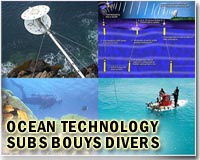| . |  |
. |
Washington DC (SPX) Mar 08, 2011 A new carbon model allows scientists to estimate sources and losses of organic carbon in surface waters in the United States. Study results indicate that streams act as both sources and sinks for organic carbon. "Model estimates help managers and researchers track carbon transport in streams, which is information that is ultimately needed to improve our understanding of the fate of rising carbon dioxide levels in the atmosphere," said Dr. Richard Smith, a USGS hydrologist and coauthor of the study. "The study contributes new information on the role of rivers as sources and sinks for organic carbon at regional and continental scales, for which scientific knowledge is rather limited." Findings show that in-stream photosynthesis by algae is a major contributor of organic carbon in large rivers of the United States. It is the largest source of organic carbon delivered to coastal waters from the Mississippi-Atchafalaya River Basin and the Pacific Northwest. Terrestrial sources of carbon, such as from forests and wetlands, are dominant in all other coastal waters, including waters of the North Atlantic, the South Atlantic Gulf, California, the Texas Gulf, and the Great Lakes. The results also provide estimates of how much of the organic carbon transported in streams is then permanently removed from the water column. The removed carbon is either sequestered in sediments over long time periods or oxidized and returned to the atmosphere as carbon dioxide. The specific fate of the carbon is not quantified in the current model. Study findings are estimated using a hydrological mass-balance model based on long-term monitoring at 1,125 stream locations and national geospatial information, including a river network of approximately 62,000 reaches and their connecting drainages, land cover, climate, soils, and estimates of the supply of carbon to streams from primary production. This USGS study was done in collaboration with researchers from Resources for the Future and Pennsylvania State University. This study is supported by the USGS National Water-Quality Assessment Program, which has assessed the physical, chemical, and biological characteristics of streams, rivers, and groundwater across the nation since 1991. Hydrologic modeling and analysis tools are important components of NAWQA studies. This newly released U.S. Geological Survey Open-File Report (2010-1276), titled An Initial SPARROW Model of Land Use and In-stream Controls on Total Organic Carbon in Streams of the Conterminous United States, by Jhih-Shyang Shih, Richard B. Alexander, Richard A. Smith, Elizabeth W. Boyer, Gregory E. Schwarz, and Susie Chung is available online only.
Share This Article With Planet Earth
Related Links United States Geological Survey Water News - Science, Technology and Politics
 Bleaching and resilience: can reefs survive?
Bleaching and resilience: can reefs survive?Wakatobi, Indonesia (AFP) March 6, 2011 Red anthia fish and rainbow-coloured wrasse dart among the glittering reefs of Indonesia's Wakatobi archipelago, as eagle rays and barracudas cruise past in the blue depths. It's hard to believe Wakatobi is anything but a thriving marine paradise, packing a bewildering abundance of life that supports 100,000 people and contributes millions of dollars to Indonesia's economy. But scientis ... read more |
|
| The content herein, unless otherwise known to be public domain, are Copyright 1995-2010 - SpaceDaily. AFP and UPI Wire Stories are copyright Agence France-Presse and United Press International. ESA Portal Reports are copyright European Space Agency. All NASA sourced material is public domain. Additional copyrights may apply in whole or part to other bona fide parties. Advertising does not imply endorsement,agreement or approval of any opinions, statements or information provided by SpaceDaily on any Web page published or hosted by SpaceDaily. Privacy Statement |